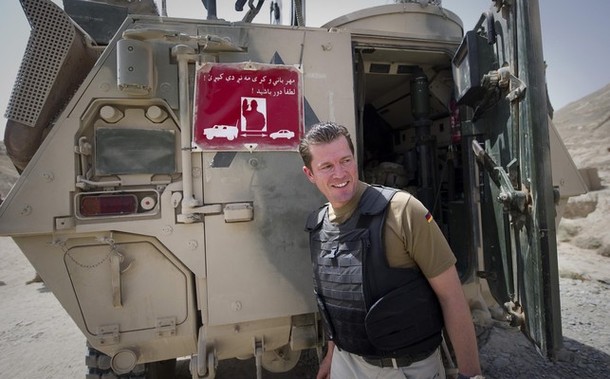
Wars fundamentally change militaries. For example, the bloody and muddy stalemate of World War I led defeated Germany to invest in the innovative use of armor and firepower to break that stalemate. The U.S. experience in Vietnam led to the rise of the professional and all-volunteer force that is now fighting in Afghanistan and Iraq.
America’s current wars are also rapidly changing the U.S. military. The emphasis on rapid network centric warfare against near-peer competitors has given way to the “COINdinistas” with their emphasis on small wars, reconstruction, and cultural awareness. The change is easy to see for even a casual observer; compare a picture of a U.S. soldier from the invasion period of the Iraq War, with a picture of the soldiers and Marines fighting in Afghanistan today. Even though they are separated by less than ten years, they seem to come from different universes.
Change in military tactics, technology, and strategy are comparatively obvious. Less visibly, the socio-cultural connections that the U.S. military has with friends and allies around the world are also changing in a manner may not bode well for the trans-Atlantic security alliance.
In military terms, the U.S. military was largely focused on Europe during the 20th Century. America fought two world wars on the European continent, stationed hundreds of thousands of troops and hundreds of nuclear weapons on European soil, and developed NATO to defend the continent against Soviet aggression and cementing U.S. influence in Europe. Today, matters look different to American leaders, both civilian and military. The rising powers of the world, and therefore the potential for great power conflict, can be found around the Pacific and America is fighting two wars, both very far from Europe. Thus, the strategic priorities have shifted away from Europe, and towards the Middle East and the Pacific. A majority of America’s deployable air and sea power can now be found in the Pacific, and the U.S. currently has only 75,000 troops stationed in Europe, down from a high of close to 450,000 in 1957. This trend is set to accelerate and be reinforced in the coming years and decades, due to the current wars being fought, and this will have a deep and lasting impact on the American military’s affinity, or lack thereof, for Europe.
Older generations of American officers remember their time in Europe with fondness, and a tour or two there usually offered the opportunity to get to know Europe and its people quite well. The presence of U.S. forces, and their families, in Europe has created a strong social and cultural bond between U.S. service members and their European host countries. This bond should not be underestimated as one of the underpinnings of the trans-Atlantic security alliance. Today, however, the bases in Europe are little more than launching pads for deployments to Iraq and Afghanistan, and the soldiers and officers there have little time to get to know the countries they are stationed in. To boot, and as mentioned earlier, relatively few U.S. service members are even stationed in Europe to begin with.
In addition to the smaller U.S. foot print in Europe, and decreasing affinity that U.S. service members have for Europe’s people and civic culture, many U.S. officers are disappointed by the performance of their European allies in Iraq and Afghanistan. For example, many perceive the Spanish performance in Iraq as largely ineffective, and Spanish troops departed Iraq quickly after the Madrid bombing and the ouster of the government in the election three days hence. Many in the U.S. military would argue that the UK left Basra in less than great shape. The British example is of special concern, since it is America’s closest ally, and that British forces used to have a reputation before Iraq of almost mystical abilities when it came to counter-insurgency and policing unruly and far-off corners of the world (what with all that experience in Northern Ireland, Bosnia, and running an empire that the sun never set on).
Things are not so different in Afghanistan. National caveats make some nations unable to conduct the full spectrum of operations, and lack of equipment and platforms, such as helicopters, makes others less than up to snuff in comparison with U.S. forces. It is not uncommon to hear junior American officers today propose alternative names for the International Security Assistance Force (ISAF); I Suck At Fighting, I Saw an American Fight, or I Sunbathe At Forward operating Bases are some of the more popular ones currently in use. In the future, it may lead some American officers to ask themselves why they should bother with NATO.
All this could of course be written off as young lieutenants, captains, and majors griping, a favorite pastime of soldiers everywhere for time eternity. However, some of these young leaders will one day be service chiefs, combatant commanders, and chairmen of the joint staff, and the conflicts and operations they participated in as young officers will influence them deeply. Generals such as Colin Powell, Norman Schwartzkopf, Barry McCaffrey, and James L. Jones were deeply influenced by their experiences as young platoon leaders during the Vietnam War, and they helped drive a major transformation of the U.S. military based in large part on that experience. One would be mistaken if the Iraq and Afghanistan did not leave a deep impression on the U.S. military of tomorrow as well.
The confluence of shifting strategic priorities for the U.S., along with a military increasingly unfamiliar with Europe at best or disdainful of America’s European allies at worst, could sever important military-to-military links that serve to underpin America’s current security relationship with Europe. The loss of this link, and what it means for NATO, may be one of the longest lasting effects of Iraq and Afghanistan.
Magnus Nordenman is associate director of the Atlantic Council’s International Security program. Photo credit: Getty.
Image: German%20DM%20Guttenberg%20with%20armored%20vehicle.jpg
